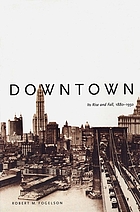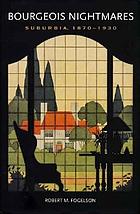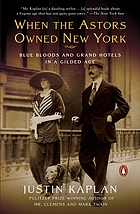Looking at my reading selections for the past couple of months, I can sort them into two basic piles: books having to do with gender/sexuality/feminism (what else is new?) and books on urban history. The urban history kick is a relatively new thing for me, prompted by a) an ongoing side research project that requires background knowledge about Boston circa the 1910s, b) the aggressive gentrification of our neighborhood -- fingers crossed we're not priced out! -- and c) happening upon a cultural history of "main street" on the new books wall at our local public library (see below). I'm going to do a collective review of the gender/sexuality/feminism books next week -- once I finish my advance review copy of this promising anthology on hard core porn -- but first, here are my thoughts on a few urban history titles.
Fogelson, Robert. Downtown: Its Rise and Fall, 1880-1950 (Yale U. P., 2001) and Bourgeois Nightmares: Suburbia, 1870-1930 (Yale U.P., 2005). More or less by accident -- Downtown was what our local library had on the shelf! -- I stumbled upon preeminent historian of urban America Robert Fogelson's work when I went in search of Boston and Brookline histories back in December. In Downtown Fogelson explores the development of the central business district in American cities -- thanks to the layout of New York City colloquially known as "downtown" regardless of geographic orientation -- and traces its fate through the first half of the twentieth century as it moved from the business district to the central business district to simply one of many business districts. He touches on a number of key cities, although New York, Boston, Chicago, and Los Angeles are recurring examples. I particularly enjoyed the attention to the perennial question of public transit and the changes wrought by the rise of the automobile. Fogelson pays particular attention to the interplay between city planners and businessmen (the urban elite) and the populace at large -- the way in which those with power seek to create and control a certain type of urban environment on the one hand, while unanticipated and often anarchic-feeling forces bring changes economic and cultural to the urban landscape.
It's the desire for stasis that is, in fact, at the heart of the second Fogelson book I read: Bourgeois Nightmares. The title, a play on Robert Fishman's Bourgeois Utopias (1987), explores the dark side of America's suburban sprawl between 1870-1930. Fogelson begins his narrative by suggesting that the central desire which drove the American upper-, upper-middle- and middle-classes to suburban subdivisions around the turn of the twentieth century was the desire for stability. In order to sell land in these new neighborhoods, subdividers had to sell the promise of that stability -- the promise that one's land would never fall in value, that one's neighborhood would remain pleasant, that one's neighbors would always be desirable. The mechanism by which they enforced stability was through the creation of restrictive covenants: contractual limitations on how landowners could use and dispose of the land which they purchased. Most notoriously, restrictions were used to exclude non-white (and sometimes non-Christian and even non-Protestant) residents from the suburban development. They were also used to police the aesthetics of place: fences, landscaping, architectural design, the domestic animals one could own, the signs one could put up, and the business one could do from one's property. Fogelson convincingly argues that restrictive covenants were a successful marketing tool despite the limitations they placed on property rights because they reassured the "bourgeois" classes that they were protected not only from outsider undesirables but also from the potentially-appalling behavior of their peer neighbors.
Holton, Wilfred and William A. Newman. Boston's Back Bay: The Story of America's Greatest Nineteenth-Century Landfill Project (Northeastern U.P., 2006). The Massachusetts Historical Society moved into the back bay in the 1890s, as the back bay landfill project was nearing its close. The land on which the MHS stands, at the corner of Boylston Street and The Fenway, teeters on the edge of landfill and what used to be known as Gravelly Point. Originally, the Back Bay served as both a source of hydro power and also Boston's sewer -- where the citizens of Boston sent their waste in hopes that the tide would wash it out to sea (a hit-or-miss proposition, particularly after the bay was sectioned by dams and railway bridges in the early 1800s. Between the 1820s and the 1890s the Commonwealth of Massachsuetts undertook the massive land-creation project of filling in the bay and what seems like the daunting task of selling the recently-noxious area as a posh neighborhood of expensive townhouses and cultural institutions. Holton and Newman are primarily interested in the engineering innovations that made filling in the Back Bay tidal flat possible and the construction of buildings feasible. Honestly, there's only so much detail about railway lines, gravel pits, and building foundations I can sustain interest for, although descriptions of the changing landscape and the generous inclusion of maps to chart the progress of land-creation were both welcome. I would have appreciated more cultural and social history. Given the Back Bay's numerous drawbacks as land for residential construction -- including a high water table that caused sewers to back up twice daily and fill basements with toxic and foul-smelling substances! -- the successful selling of the neighborhood as a desirable location for the Boston elites is a story that begs to be told in more depth. Still, I do feel I now have a better grasp on the whys and hows of the Back Bay landfill project. Now on to Nancy Seashole's Gaining Ground: A History of Landmaking in Boston (MIT Press, 2003).
Kaplan, Justin. When the Astors Owned New York: Blue Bloods and Grand Hotels in the Gilded Age (Viking, 2006). One feature of American downtown life in the Gilded Age was the luxury hotel. Using the real estate giants William Waldorf Astor and his cousin John Jacob Astor as his biographical through-line, Justin Kaplan offers a lively tour of the rise of the modern-day hotel during the late nineteenth-century. What I found most fascinating about the book -- apart from the salacious details of intra-familial rivalry -- was the cultural history of a type of institution (the luxury hotel) that today we take more or less for granted as an essential feature in any city. Yet the first establishment that approximated what we think of as a hotel, The Tremont here in Boston, opened in 1829. It was the first lodging-house to become a destination per se rather than just a place for businessmen and travelers to find a bed and a meal in transit from one location to the next. Its indoor bathrooms, particularly, became so popular that upperclass families in the nearby Beacon Hill neighborhood sometimes made there way to the hotel for their weekly bath. The Astor family built on these innovations with alacrity and by the end of the 1800s their hotels in New York City were the subject of songs, the hub of high society, where people went to see and be seen. While Kaplan's narrative is short on footnotes, it is grounded in the historical record and is not overly ambitious in its claims. An entertaining and informative read.
Orvell, Miles. The Death and Life of Main Street: Small Towns in American Memory, Space and Community (University of North Carolina Press, 2012). Orvell's work is a cultural history of "main street" in America -- both how it actually functioned in the social and economic landscape and also what it signified in the American mind. Examining literary and cinematic portrayals as well as the politics of creating, destroying, and rehabilitating "main street" as a social space throughout the 19th and 20th centuries, Orvell points to the ongoing tension in the American cultural landscape between "main street" as a site for wholesome enjoyment and small-town safety and main street as a site for small-mindedness and community policing. The idyllic nature of small-town / "main street" America, in other words, very often depends on the erasure of people whose presence is disruptive to "niceness": educated women with uppity notions about gender equality, labor organizers, and -- over and over again -- those whose skin color, ethnicity, and religion fail to conform with a WASP-y vision of true American-ness. From 19th-century paeons to the "vanishing" New England village square to late-20th century Disney-sponsored planned communities, The Death and Life of Main Street offers a highly readable, well-researched window into one particular facet of the (real and mythical) American landscape.
Next on the urban history reading list is Stephen Puleo's A City So Grand: The Rise of an American Metropolis, Boston 1850-1900 (Beacon Press, 2010). I'll be sure to let you know how it goes! But next week we'll be taking a turn to a mix of books both historical and cultural that touch on human sexuality and the politics thereof.





No comments:
Post a Comment